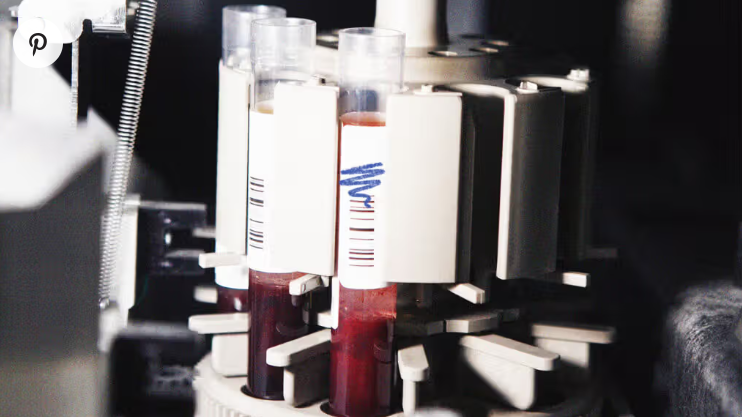- Blood tests can be used to detect protein circulating in the blood.
- These proteins can, and are used to determine and predict our health, as they give an insight into what levels different systems are operating at.
- Many diseases, particularly uncommon diseases, are difficult to diagnose as there is no known blood test that can be used to detect them.
- A team of researchers used UK Biobank data to determine which proteins could be used to detect over 60 conditions.
Researchers have identified protein signatures in blood tests that can be used to detect or predict up to 67 diseases, using UK Biobank data in a cohort of nearly 42,000 participants.
They say they can more accurately identify whether diseases, including multiple myeloma, non-Hodgkin lymphoma, and motor neuron disease, will develop in the next 10 years than traditional clinical history taking.
“Proteomics is the study of structure and function of proteins wherever they are found in our bodies. Since proteins are key players in oncogenesis, their identification can be correlated with existing disease, spread of disease, or in the early stages of initiation of transformation from normal cells to malignant ones,” said Richard Reitherman, MD, PhD, board certified radiologist at MemorialCare Breast Center at Orange Coast Medical Center in Fountain Valley, CA, who was not involved in the research.
“For example, blood levels of PSA (prostate-specific antigen) are used as a screening test for the existence of prostate cancer or its spread in men who have been treated for prostate cancer,” he told Medical News Today .
The results were published in Nature Medicine.
Researchers from GlaxoSmithKline (GSK), the U.K., and Germany highlighted that while certain clinical measurements and history-taking can be used to predict the risk of developing some common diseases, people with rarer diseases do not benefit as much from this clinical model. The lack of blood tests for some conditions means there are delays in their diagnosis.
To quantify this, the researchers looked at traditionally collected clinical measures for a subset of nearly 42,000 U.K. Biobank participants whose data was released as part of the U.K.’s Biobank Pharma Proteomics Project. Participants in this subset had collectively been diagnosed with 218 pathologically diverse diseases.
The clinical data researchers collected on them included:
- Age
- Sex
- BMI
- Self-reported ethnicity
- Smoking status
- Alcohol consumption
- Self-reported paternal or maternal history
The scientists discovered that endocrine and cardiovascular diseases were among the best predicted using these clinical measures.
They then analyzed blood plasma data to identify potential protein predictors of 218 diseases in 70–75% of participants. They discovered that for 163 diseases, a biomarker signature of just five proteins alone predicted disease as well as the clinical model. For 67 diseases, the detection of the presence of just 5–20 proteins significantly improved clinical models.
For these 67 diseases, the median detection rate using the protein signature was 45.5% compared with 25% when just the clinical model was used, with a 10% false positive rate.
These diseases included:
- Multiple myeloma
- Non-Hodgkin lymphoma
- Pulmonary fibrosis
- Celiac disease
- Dilated cardiomyopathy
- Motor neuron disease
Researchers predicted for celiac disease, a condition that can present ‘silently’ and requires invasive testing to diagnose, using a protein detection test for the condition would result in 80% of cases being detected, with a 10% false positive rate.
They then validated these findings with the remaining 25-30% of the cohort.
For 14 of the 41 diseases the researchers tested, the predictive performance of the protein signatures differed between men and women.
The researchers did not investigate why the observed differences in blood protein occurred when certain diseases developed, but it was something that was currently being tested, said lead author Claudia Langenberg MD, PhD, Director, Precision Healthcare University Research Institute and Professor of Medicine and Population Health and Queen Mary University of London.
“Most studies do not test prediction of ‘future’ events, as this requires much larger numbers, but we are currently checking how early before disease onset protein changes that are evident at or after diagnosis are seen,” she told MNT.

I do not even know how I ended up here but I thought this post was great I do not know who you are but certainly youre going to a famous blogger if you are not already Cheers
I just could not leave your web site before suggesting that I really enjoyed the standard information a person supply to your visitors Is gonna be again steadily in order to check up on new posts
Nice blog here Also your site loads up fast What host are you using Can I get your affiliate link to your host I wish my web site loaded up as quickly as yours lol
Wonderful beat I wish to apprentice while you amend your web site how could i subscribe for a blog web site The account aided me a acceptable deal I had been a little bit acquainted of this your broadcast provided bright clear idea
Thank you for the good writeup It in fact was a amusement account it Look advanced to far added agreeable from you However how could we communicate
Attractive section of content I just stumbled upon your blog and in accession capital to assert that I get actually enjoyed account your blog posts Anyway I will be subscribing to your augment and even I achievement you access consistently fast
I loved as much as youll receive carried out right here The sketch is tasteful your authored material stylish nonetheless you command get bought an nervousness over that you wish be delivering the following unwell unquestionably come more formerly again since exactly the same nearly a lot often inside case you shield this hike